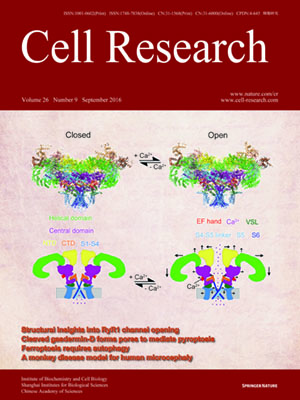
Volume 26, No 9, Sep 2016
ISSN: 1001-0602
EISSN: 1748-7838 2018
impact factor 17.848*
(Clarivate Analytics, 2019)
Volume 26 Issue 9, September 2016: 1067-1070
LETTERS TO THE EDITOR
A genome-wide loss-of-function screening method for minimizing false-negatives caused by functional redundancy
Li Mao1,*, Chenglin Liu2,3,*, Zhen Wang2, Xiaofeng Niu1, Liang Xue1, Zhilei Zhou1, Zhenying Cai1, Meng Yu1,4, Yixue Li2,3,5, Dianqing Wu6 and Lin Li1
1State Key Laboratory of Molecular Biology, CAS Center for Excellence in Molecular Cell Science, Innovation Center for Cell Signaling Network, Institute of Biochemistry and Cell Biology, Shanghai 200031, China
2Key Laboratory of Computational Biology, CAS-MPG Partner Institute for Computational Biology, Shanghai Institutes for Biological Sciences, Chinese Academy of Sciences, Shanghai 200031, China
3School of Life Sciences and Biotechnology, Shanghai Jiaotong University, Shanghai, China
4School of Life Science and Technology, Shanghai Tech University, Shanghai 200031, China
5Collaborative Innovation Center for Genetics and Development, Fudan University, Shanghai, China
6Vascular Biology and Therapeutic Program and Department of Pharmacology, Yale School of Medicine, New Haven, CT 06520, USA
Correspondence: Lin Li, E-mail: lli@sibs.ac.cn; Dianqing Wu, E-mail: dianqing.wu@yale.edu; Yixue Li,(yxli@sibs.ac.cn)
Loss-of-function screens are powerful tools for identifying gene contribution in a given biological context. Over the past decade, the RNA interference technology has become a dominant approach in the loss-of-function screen-based gene discovery1. However, about 3 quarters of genes in mammalian genomes belong to gene families and have functional redundant homologs. While this functional redundancy protects cells and organisms from deleterious mutations2, it also masks phenotypic outcomes, resulting in false-negatives in loss-of-function screens that target individual genes. However, all of reported loss-of-function screens have been designed to target individual genes and thus suffer from limitations of the false-negatives.
10.1038/cr.2016.97
FULL TEXT | PDF
Browse 1931


